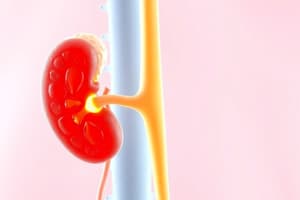Podcast
Questions and Answers
What role do the kidneys primarily play in fluid and electrolyte balance?
What role do the kidneys primarily play in fluid and electrolyte balance?
- Assist in gas exchange
- Control water and ion excretion (correct)
- Manage muscle contractions
- Regulate heart rate and blood pressure
How does high osmolarity affect urine production?
How does high osmolarity affect urine production?
- Has no effect on urine production
- Alters urine composition
- Increases urine production
- Decreases urine production (correct)
Which structure contributes to the creation of high osmolarity in the renal medulla?
Which structure contributes to the creation of high osmolarity in the renal medulla?
- Collecting duct
- Thick ascending limb of the loop of Henle (correct)
- Distal convoluted tubule
- Glomerulus
What is the function of the vasa recta in relation to urine concentration?
What is the function of the vasa recta in relation to urine concentration?
Which system provides faster compensation for fluid and electrolyte imbalances?
Which system provides faster compensation for fluid and electrolyte imbalances?
What is the primary action of atrial natriuretic peptide (ANP)?
What is the primary action of atrial natriuretic peptide (ANP)?
Which condition is characterized by too much potassium in the blood?
Which condition is characterized by too much potassium in the blood?
Which mechanism triggers thirst in the body?
Which mechanism triggers thirst in the body?
What role does the hormone aldosterone play in the body?
What role does the hormone aldosterone play in the body?
What is one of the main responses to dehydration?
What is one of the main responses to dehydration?
What effect does vasopressin have on the permeability of the collecting duct?
What effect does vasopressin have on the permeability of the collecting duct?
Under which condition would vasopressin release be stimulated?
Under which condition would vasopressin release be stimulated?
What happens to urine concentration when vasopressin levels are high?
What happens to urine concentration when vasopressin levels are high?
Where are vasopressin receptors located in relation to the principal cells?
Where are vasopressin receptors located in relation to the principal cells?
Which receptors are primarily responsible for monitoring blood pressure and blood volume?
Which receptors are primarily responsible for monitoring blood pressure and blood volume?
What is the primary action of vasopressin on kidney function?
What is the primary action of vasopressin on kidney function?
What triggers the release of vasopressin from the posterior pituitary?
What triggers the release of vasopressin from the posterior pituitary?
What stimulates the secretion of aldosterone?
What stimulates the secretion of aldosterone?
Which mechanism does aldosterone use to increase sodium absorption?
Which mechanism does aldosterone use to increase sodium absorption?
Which enzyme converts angiotensin I to angiotensin II?
Which enzyme converts angiotensin I to angiotensin II?
What effect does aldosterone have on potassium levels in the body?
What effect does aldosterone have on potassium levels in the body?
What is the primary source of aldosterone production?
What is the primary source of aldosterone production?
How does aldosterone affect the Na+/K+ ATPase activity?
How does aldosterone affect the Na+/K+ ATPase activity?
Which of the following statements about renin secretion is TRUE?
Which of the following statements about renin secretion is TRUE?
Which condition is NOT a stimulus for aldosterone secretion?
Which condition is NOT a stimulus for aldosterone secretion?
What is the role of natriuretic peptides in the aldosterone secretion process?
What is the role of natriuretic peptides in the aldosterone secretion process?
Flashcards
High Osmolarity
High Osmolarity
High concentration of solutes in the blood, leading to lower water volume and less urine production.
Low Osmolarity
Low Osmolarity
Low concentration of solutes in the blood, leading to higher water volume and more urine production.
Countercurrent Multiplier
Countercurrent Multiplier
A mechanism in the loop of Henle that actively transports Na+, Cl-, and K+ out of the nephron, creating a high osmolarity in the interstitial fluid of the medulla.
Vasa Recta
Vasa Recta
Signup and view all the flashcards
Urea's Role
Urea's Role
Signup and view all the flashcards
Vasopressin's Role
Vasopressin's Role
Signup and view all the flashcards
How Vasopressin Works
How Vasopressin Works
Signup and view all the flashcards
Vasopressin Graded Effect
Vasopressin Graded Effect
Signup and view all the flashcards
Vasopressin Release Stimuli
Vasopressin Release Stimuli
Signup and view all the flashcards
Osmoreceptors
Osmoreceptors
Signup and view all the flashcards
Baroreceptors
Baroreceptors
Signup and view all the flashcards
Vasopressin's Cellular Action
Vasopressin's Cellular Action
Signup and view all the flashcards
Natriuretic Peptides
Natriuretic Peptides
Signup and view all the flashcards
ANP's Effect on Sodium
ANP's Effect on Sodium
Signup and view all the flashcards
Hyperkalemia
Hyperkalemia
Signup and view all the flashcards
Hypokalemia
Hypokalemia
Signup and view all the flashcards
Salt Appetite
Salt Appetite
Signup and view all the flashcards
Aldosterone: Where's it made?
Aldosterone: Where's it made?
Signup and view all the flashcards
Aldosterone's Role
Aldosterone's Role
Signup and view all the flashcards
Triggering Aldosterone
Triggering Aldosterone
Signup and view all the flashcards
Aldosterone and Sodium
Aldosterone and Sodium
Signup and view all the flashcards
Aldosterone and Potassium
Aldosterone and Potassium
Signup and view all the flashcards
Renin: What's it for?
Renin: What's it for?
Signup and view all the flashcards
RAAS: The Pathway
RAAS: The Pathway
Signup and view all the flashcards
Angiotensin II: The Action
Angiotensin II: The Action
Signup and view all the flashcards
Low Blood Pressure: The Triggers
Low Blood Pressure: The Triggers
Signup and view all the flashcards
Aldosterone: The Final Goal
Aldosterone: The Final Goal
Signup and view all the flashcards
Study Notes
Fluid and Electrolyte Homeostasis
- Renal, respiratory, and cardiovascular systems control fluid and electrolyte balance.
- Renal compensation is slower than respiratory and cardiovascular compensation.
- Renal/kidney function is controlled by endocrine/neuroendocrine systems.
- Respiratory and cardiovascular systems are controlled by neural systems.
- High osmolarity equals low water volume, leading to less urine output.
- Low osmolarity equals high water volume, leading to more urine output.
- Kidneys are the primary route for ion and water excretion.
Countercurrent Multiplier in the Loop of Henle
- The loop of Henle creates high osmolarity in the interstitial fluid of the medulla by actively transporting Na+, Cl-, and K+ out of the nephron in the thick ascending limb.
- This process is required for concentrating urine as the filtrate flows through the collecting duct.
- Pumping ions establishes a gradient enabling other substances to passively follow.
- The vasa recta capillaries act as a countercurrent exchanger, removing water that leaves the nephron, thus preventing dilution of the medulla interstitial fluid.
- Urea plays a significant role in increasing interstitial osmolarity.
Water Balance and Vasopressin
- Vasopressin (AVP/ADH) controls water permeability in the collecting duct, impacting urine concentration based on body water needs.
- Increased vasopressin leads to increased water reabsorption, resulting in concentrated urine.
- Decreased vasopressin leads to decreased water reabsorption, resulting in dilute urine.
- Vasopressin release is triggered by high plasma osmolarity, low blood volume, or low blood pressure, stimulating osmoreceptors in the hypothalamus and baroreceptors in the heart and blood vessels.
Renin-Angiotensin-Aldosterone System (RAAS)
- Aldosterone secretion is stimulated by angiotensin II.
- Low blood pressure triggers the release of renin from granular cells in the kidney.
- Renin converts angiotensinogen to angiotensin I, which is then converted to angiotensin II by ACE.
- Angiotensin II stimulates aldosterone secretion from the adrenal cortex.
- Aldosterone increases sodium reabsorption and potassium secretion in principal cells of the distal tubule and collecting duct.
- RAAS responses help regulate blood pressure, maintaining sodium balance, and controlling ECF volume.
- Low blood pressure triggers renin production via three mechanisms: increasing sympathetic activity, direct stretch sensing in granular cells, and low glomerular filtration rate leading to decreased NaCl transport in the macula densa.
Natriuretic Peptides
- Atrial natriuretic peptide (ANP) and brain natriuretic peptide (BNP) are released in response to high blood volume and stretch.
- They promote sodium excretion and water loss.
- ANP and BNP decrease renin and aldosterone release, and increase glomerular filtration rate.
- They act to lower blood volume and blood pressure.
Potassium Balance
- Potassium homeostasis keeps plasma K+ concentrations in a narrow range.
- Hyperkalemia (high potassium) can lead to cardiac arrhythmias.
- Hypokalemia (low potassium) can lead to muscle weakness and respiratory muscle failure.
Acid-Base Balance and Compensation
- CO2 from respiration is a major source of acid (H+).
- CO2 combines with water to produce H+ and bicarbonate (HCO3–).
- The body uses three mechanisms to regulate pH:
- Buffers (proteins, phosphate ions, and bicarbonate) to immediately neutralize pH changes.
- Ventilation adjusting CO2 levels influences the acid/base balance.
- Kidneys regulating bicarbonate reabsorption and H+ secretion.
- Abnormal pH can alter the nervous system's function, resulting in acidosis (CNS depression) or alkalosis (CNS or muscle hyperexcitability).
Renal Compensation
- Kidneys adjust pH by regulating H+ secretion and HCO3-- excretion within the nephrons.
- Type A intercalated cells in the kidney help correct acidosis.
- Type B intercalated cells help correct alkalosis.
Studying That Suits You
Use AI to generate personalized quizzes and flashcards to suit your learning preferences.




